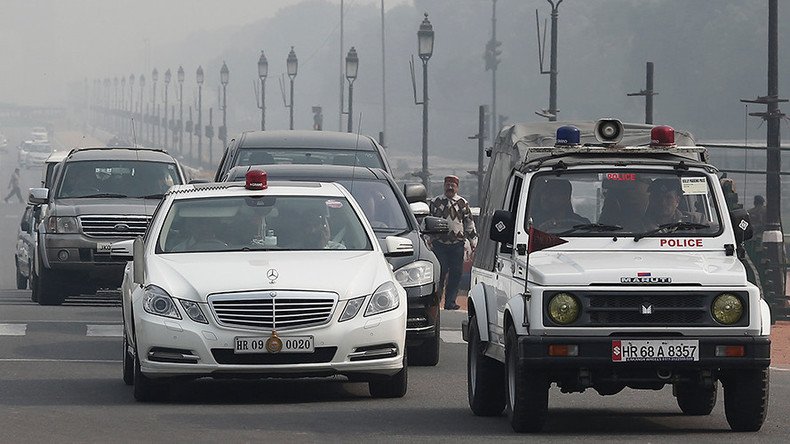India bans elitist red beacons from VIPs’ cars, including for PM and president

In a bid to scrap elitist VIP culture, India’s government has decided to ban all red beacons from vehicles belonging to state officials. The legislation doesn’t even exempt vehicles transporting the country’s prime minister, president, or heads of states.
From May 1, Lal Batti, or red beacons, will be banned from all vehicles on India’s congested streets. Only emergency services, including ambulances, firemen’s vehicles, and police cars, will be able to use blue lights.
“We are removing the rule which allows state and central government to specify who can use the red lights,” Minister of Finance, Defence, and Corporate Affairs Arun Jaitley said at a news conference in New Delhi.
“From May 1, no vehicle will have a red light. There will be no exceptions,” he said.
High-ranking officials have long used red lights in India to cut through traffic while on official trips, when police often erect barricades and block routes for ‘common’ vehicles.
It should have gone long ago. Glad that today a strong beginning has been made. https://t.co/25BxLdlDpp
— Narendra Modi (@narendramodi) April 19, 2017
However, this symbol of influence and privilege is often used (or misused) by minor officials, mainly in smaller towns, who want to show off and boast of their position, according to reports in the Indian media.
“This is a central rule and the government is removing this rule from the rule book. Its abolition would mean that neither the Centre nor the States would have any dignitary that governments can nominate for the usage of red beacons,” Jaitley said.
According to Road Transport Minister Nitin Gadkari, the ban “is a huge democratic decision.”
“This government is a government of common masses and thus we have decided to abolish the VIP culture of beacon lights and sirens,” he said.
Immediately after the red beacon ban was announced, Prime Minister Narendra Modi took to Twitter to hail the decision.
“Every Indian is special. Every Indian is a VIP,” he wrote.
Every Indian is special. Every Indian is a VIP. https://t.co/epXuRdaSmY
— Narendra Modi (@narendramodi) April 19, 2017
Thank you. These symbols are out of touch with the spirit of new India. https://t.co/xCMaSn48mc
— Narendra Modi (@narendramodi) April 19, 2017
Earlier in April, Modi went to Delhi Airport to meet his Bangladeshi counterpart, Sheikh Hasina, “in normal traffic,” according to reports in the Indian media. No traffic restrictions were imposed during his trip to the airport.
In the meantime, hashtag #EveryoneVIPinNewIndia has been trending on Twitter, with people calling the ban “historic”.
Congrats PM @narendramodi on this historic step to abolish VIP culture in India. #RIP#REDBEACON. #EveryoneVIPinNewIndia
— Ambarsariya!! (@jotbir) April 20, 2017
This is New India where we have a PM @narendramodi who believes that every common man is VIP #EveryoneVIPinNewIndia
— Kishan laddha (@bjpkishanladdha) April 20, 2017
Historic decision taken by Narendra Modi govt, red beacons 'Lal Batti' culture comes to an end. No VIP class anymore. #EveryoneVIPinNewIndiapic.twitter.com/PsUTo4fhUX
— vinit rajput 007 (@VImvinit007) April 20, 2017
Welcome to India 🇮🇳 where #EveryoneVIPinNewIndia all are equal.This is attitude of unity and simplicit.#mynewindia is rising! @narendramodi
— Shivam Patel (@patelshivam_) April 20, 2017
@narendramodi ji proved it once again that he is a true leader.
— Vince Sheldon (@livinglord) April 20, 2017
"Every Indian is a VIP"#EveryoneVIPinNewIndiahttps://t.co/epi4c1fzws
" Every Indian is a VIP" that's called a historic landmark decision. Proud to have a PM like you @narendramodi#EveryoneVIPinNewIndia
— subham das (@subhamvikash) April 20, 2017
Many politicians posted photos and videos on Twitter showing them removing red beacons from their vehicles.
Among them was Devendra Fadnav, chief minister of the state of Maharashtra in western Indian:
Maharashtra CM @Dev_Fadnavis removes the #RedBeacon from his car immediately as the GoI decided to take this step to end #vipculturepic.twitter.com/CB1ucbx5XA
— CMO Maharashtra (@CMOMaharashtra) April 19, 2017
Union Minister for Women and Child Development Maneka Gandhi:
And with that we have proven that #EveryoneVIPinNewIndia. A welcome step by PM Shri @narendramodi ji. #RedBeaconpic.twitter.com/0dI7FoMJkV
— Maneka Gandhi (@Manekagandhibjp) April 19, 2017
And Vijay Rupani, chief minister of India’s westernmost state, Gujarat:
ગુજરાત ના માન.મુખ્યમંત્રી શ્રી @vijayrupanibjp એ ગાડી પરની 'લાલ બત્તી' હટાવી. #EveryoneVIPinNewIndiapic.twitter.com/3qXIi0nnbX
— Nimaben Acharya BJP (@Nimaben_BJP) April 20, 2017
However, some politicians didn’t wait for the official ban to remove their red beacons. Chief Minister of Delhi Arvind Kejriwal, who has repeatedly called for the ban, stated in 2015 that neither he nor his cabinet used the VIP symbol.
However, there were those who questioned the ban’s importance, saying that it’s hardly likely that government officials will change their “mindset just by removing red lights.”
@PMO@PMO_India bureaucrats slapping petrol pump employees. sir, how would you change mindset just by removing red beacons from vehicles???? https://t.co/BNgVKBGxzY
— Rajeev Sharma (@alrightsirji) April 20, 2017
@timesofindia@arunjaitley Its not the red beacon thats causing distress for the common man. Its the procession and blocking of roads. When will that stop ?
— Praveen Arakkal (@PraveenArakkal) April 20, 2017
Others said the ban won’t remove the “red beacon” from the minds of VIP politicians.
@MVenkaiahNaidu Banning of Red Beacon on top of car/ vehicle will not stop VIP culture. Who will remove Red Beacon from their mind?
— Mansukhpatel1895@gma (@mansukhpatel181) April 20, 2017
@CNNnews18@capt_amarinder Remove the mindset and not the red beacon lights Ask MLA to do good work for the welfare of the people.That's imp
— KUPPACHI RAVI (@KUPPACHIRAVI) March 18, 2017












